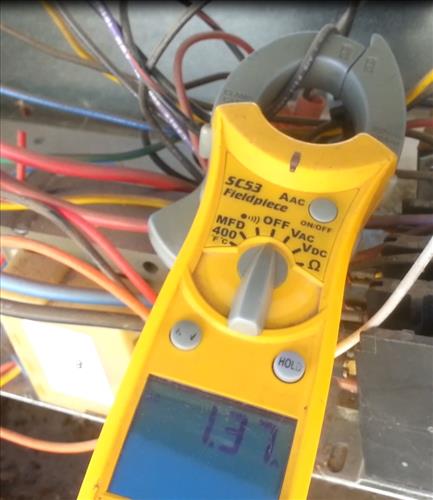Draw amp checking amps check hvac training step technician
Table of Contents
Table of Contents
Do you know how to check amp draw? Checking the amperage of an electrical system is an important part of troubleshooting and preventative maintenance. Whether you’re an HVAC technician or a DIY enthusiast, knowing how to test amp draw can save you time and money in the long run.
When something goes wrong with an electrical system, it can be frustrating and time-consuming to troubleshoot. You may experience issues like blown fuses or circuit breakers, malfunctioning equipment, or inefficient operation. These issues can often be traced back to problems with the amp draw, which is why testing amperage is such an important part of electrical maintenance.
The process of checking amp draw involves measuring the flow of electrical current through a system. This measurement can identify issues like overloaded circuits, loose connections, or faulty equipment. By testing amperage, you can pinpoint the source of electrical problems and avoid costly repairs down the line.
In summary, to check amp draw, you’ll need a multimeter, a basic understanding of electrical systems, and specific knowledge of the equipment or appliance you’re testing. You’ll also need to follow proper safety precautions to avoid electrical shocks or other hazards.
How to Check Amp Draw: A Guided Overview
As an HVAC technician, I’ve spent countless hours testing amp draw on various types of equipment. While the specifics of electrical testing can vary depending on the system you’re working with, there are some general steps you can follow to get started:
Step 1: Prepare Your Equipment and Safety Gear
Before you begin testing, make sure you have the right tools and protective gear. You’ll need a multimeter, a clamp meter, and personal protective equipment like gloves and goggles.
You should also turn off power to the system you’re working on and lock the breaker or disconnect. This will prevent accidental electrocution.
Step 2: Connect the Multimeter to the Circuit
Next, connect the multimeter to the circuit you’re testing. This may involve attaching probes or leads to specific points on the system.
Make sure to set the multimeter to the right setting, based on the type of electrical current you’re measuring.
Step 3: Monitor the Amp Draw
Once you’re connected to the circuit, turn on the equipment and monitor the amp draw. This may involve using the clamp meter to measure the amperage on specific wires or parts of the system.
Record your readings and compare them to the manufacturer’s specifications, or to previous readings from the same system or piece of equipment.
Step 4: Interpret the Results
Based on your amp draw readings, you may identify issues like overloaded circuits, faulty wiring, or worn-out components. Use this information to troubleshoot and make repairs as necessary.
Remember to follow proper safety procedures and best practices for electrical testing. And if you’re ever unsure about how to test amp draw on a specific system or piece of equipment, don’t hesitate to consult a professional for assistance.
What Is the Purpose of Testing Amp Draw?
As mentioned earlier, checking amp draw is an essential part of electrical troubleshooting and preventative maintenance. By monitoring amperage levels in your systems and equipment, you can identify issues before they cause major problems.
Testing amp draw can also help you optimize energy efficiency and reduce operating costs. By ensuring that each system and piece of equipment is operating at peak performance, you can save money on utilities and improve overall system performance over the long term.
What Should You Look for When Testing Amp Draw?
When you’re testing amp draw with a multimeter or clamp meter, there are several factors to pay attention to. These include:
- The type of electrical current (AC or DC)
- The amperage rating of the circuit or equipment
- The load on the system or equipment
- The condition of wiring and other components
By keeping these factors in mind and monitoring amperage levels over time, you can gain valuable insights into how your equipment is performing and identify issues before they become major problems.
Question & Answer
Q: How often should you test amp draw on your electrical systems? A: The frequency of testing will depend on the specific system or equipment you’re working with. As a general rule of thumb, you should test amp draw at least once a year for preventative maintenance. If you notice any issues with the system or equipment, you may need to test more frequently.
Q: What happens if the amp draw is too high or too low? A: If the amp draw is too high, it may indicate an overloaded circuit or an issue with the equipment. If the amp draw is too low, it may indicate a problem with the wiring or other components. In either case, you may need to troubleshoot and make repairs to get the system or equipment back to peak performance.
Q: Can I test amp draw myself, or should I hire a professional? A: It’s possible to test amp draw yourself if you have the necessary equipment and knowledge. However, if you’re ever unsure or uncomfortable with the testing process, it’s best to consult a professional for assistance.
Q: What are some common mistakes to avoid when testing amp draw? A: Some common mistakes include using the wrong type of multimeter or clamp meter, failing to turn off power to the system, and not following proper safety procedures. Make sure to research the specific testing requirements for your system or equipment and follow all instructions carefully.
Conclusion of How to Check Amp Draw
Testing amp draw is an essential part of maintaining electrical systems and equipment. By following the steps outlined in this guide and observing best practices for electrical testing, you can identify issues before they become major problems and optimize performance over the long term.
Gallery
How To Check Amp Draw On A Blower Motor

Photo Credit by: bing.com /
Preventative Maintenance On A ICP Gas Pack – HVAC How To

Photo Credit by: bing.com / motor draw amp blower fan icp test gas hvac checking amps preventative maintenance pack testing measure condensing flames look if
HVAC Technician Training: Step 13 Checking Amp Draw | Freedom HVAC AL

Photo Credit by: bing.com / draw amp checking amps check hvac training step technician
Story Time, Troubleshooting Goodman Condenser - HVAC Beginners

Photo Credit by: bing.com / goodman condenser troubleshooting contactor compressor
How To Test Amperage / Amp Draw And Properly Measure And Fuse A Circuit

Photo Credit by: bing.com / multimeter test car amplifier amp amperage draw measure circuit fuse






